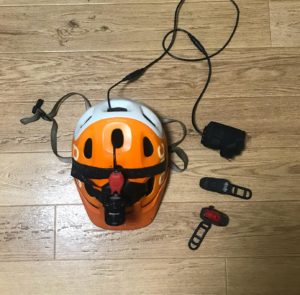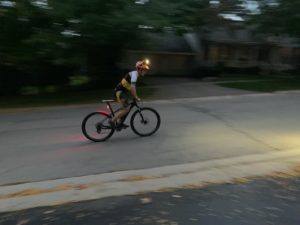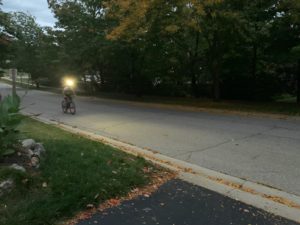By Ross DiFalco
As the days get shorter and cooler, you might find yourself coming home from work in the dark without the ability to ride outside. Instead of relegating yourself to the indoor trainer, you do have another option. You can learn to ride in the dark. For the uninitiated, riding in the dark may sound crazy and scary, but it doesn’t have to be.
You will need a good set of lights. I recommend getting a helmet mounted headlight with an external battery. If you have a spare helmet, I find it beneficial to keep the light mounted so it’s one less hurdle. Get one with greater than 1000 lumens that can run for a minimum of two hours. When you test a light, it might seem bright, but while you are riding it will seem much less so. Brighter is better, with a long beam distance being very important. You also should have a backup light on your handlebar for a “just in case” moment. There should be two rear facing lights as well. I like a very bright seat post strobe light and a helmet strobe light. The name of the game is being seen and being able to see.
 Once you have your lights and have charged them, it’s time to select your bike. If you are like many cyclists, you probably have a bike for every niche around. For night riding I highly recommend using a mountain bike. Having flat wide handlebars, an upright riding position and wide tires/suspension all act as a pothole security policy. Potholes sneak up on you and it would be bad to crash in the middle of the night. If in case you do crash, ride with your phone charged. Before you head out the door, tell someone where you are going and how long you will be gone.
Once you have your lights and have charged them, it’s time to select your bike. If you are like many cyclists, you probably have a bike for every niche around. For night riding I highly recommend using a mountain bike. Having flat wide handlebars, an upright riding position and wide tires/suspension all act as a pothole security policy. Potholes sneak up on you and it would be bad to crash in the middle of the night. If in case you do crash, ride with your phone charged. Before you head out the door, tell someone where you are going and how long you will be gone.
Let’s get riding!
Choose a route that has minimal traffic, and preferably slow traffic. I really like riding through neighborhoods, dirt roads, paths, and rail to trails. I avoid riding on sidewalks and roads with minimal shoulders. It’s very similar to riding in the light, those areas tend to pose the greatest risk to cyclists. Do be aware that a bright helmet mounted light can blind drivers so be cognizant of where you look. Another word of caution, deer are much more active at dawn and dusk. Watch out for deer that might hop out in front of you.
 Take it slow, get used to the feeling of riding in the dark, and enjoy the differences. I am a cyclist that loves to get outside and be in nature. If I can ride longer outside and avoid my trainer, I will gladly do so. If you are like me, give riding in the dark a try! It’s an exciting feeling to glide through the night in the chilly fall air.
Take it slow, get used to the feeling of riding in the dark, and enjoy the differences. I am a cyclist that loves to get outside and be in nature. If I can ride longer outside and avoid my trainer, I will gladly do so. If you are like me, give riding in the dark a try! It’s an exciting feeling to glide through the night in the chilly fall air.











